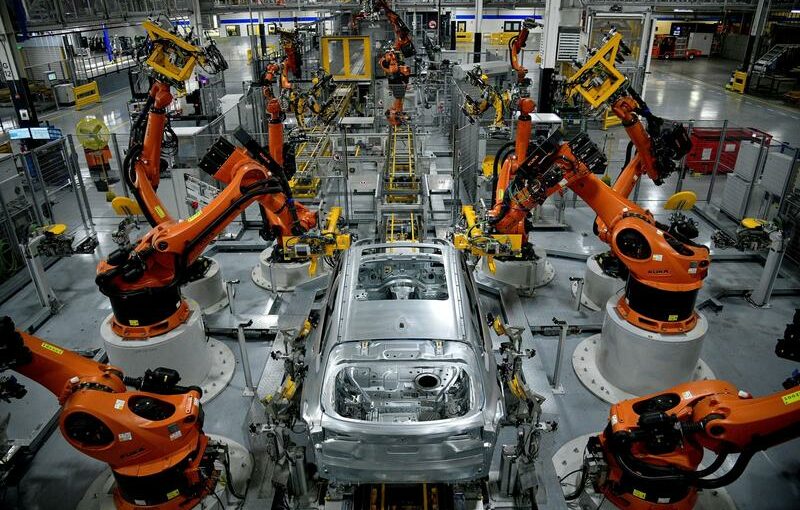WASHINGTON (Reuters) -U.S. manufacturing activity grew at a slower pace in July for the second straight month as raw material shortages persisted, though there are signs of some easing in the supply-chain bottlenecks.
The survey from the Institute for Supply Management (ISM) on Monday showed measures of prices paid by manufacturers and supply deliveries fell last month. ISM chair Timothy Fiore noted that “supply and demand dynamics appear to be moving closer to equilibrium for the first time in many months.”
Part of that could be because spending is rotating back to services from goods.
“Manufacturing is slowing from unsustainable boom to sustainable strength,” said Chris Low, chief economist at FHN Financial in New York. “Moderation in supplier deliveries and prices paid indicate bottlenecks are alleviating, but both remain high enough to indicate supply-side problems persist. Still, from a markets and policy perspective, progress is important.”
The ISM’s index of national factory activity fell to 59.5 last month, the lowest reading since January, from 60.6 in June.
A reading above 50 indicates expansion in manufacturing, which accounts for 11.9% of the U.S. economy. Economists polled by Reuters had forecast the index little changed at 60.9.
Seventeen out of 18 manufacturing industries reported growth in July, including furniture and related products, computer and electronic products, machinery and fabricated metal products. Only textile mills reported a decline.
The ISM survey’s measure of prices paid by manufacturers fell to a reading of 85.7 last month from a record 92.1 in June. The drop – the largest pullback in the index since March 2020 – supports Federal Reserve Chair Jerome Powell’s contention that inflation will moderate as supply constraints abate.
The Fed’s preferred inflation measure, the personal consumption expenditures price index, excluding the volatile food and energy components, shot up 3.5% year-on-year in June, the largest gain since December 1991.
The survey’s measure of supplier deliveries fell to 72.5 from a reading of 75.1 in June.
Some of the slowdown in manufacturing reflects a shift in demand to services from goods. Nearly half of the population has been fully vaccinated against COVID-19, allowing Americans to travel, frequent restaurants, visit casinos and attend sporting events among services-related activities that were curbed early in the pandemic.
Government data last week showed spending on services accelerated sharply in the second quarter, helping to lift the level of gross domestic product above its peak in the fourth quarter of 2019.
U.S. stocks were trading higher, with the S&P 500 index near a record high as a $1 trillion infrastructure bill buoyed sentiment. The dollar fell against a basket of currencies. U.S. Treasury prices rose.
LEAN INVENTORIES
The ISM survey’s forward-looking new orders sub-index fell to a reading of 64.9 last month from 66.0 in June. That was the second straight monthly decline. But with inventories at factories remaining lean and business warehouses almost empty, the moderation in new orders growth is likely to reverse or remain minimal.
Businesses depleted inventories at a rapid clip in the second quarter. Stocks at retailers are well below normal levels. Economists at Goldman Sachs expect retail and auto inventories will return to normal levels in mid-2022.
Production at factories slowed last month, leading to a rise in the backlog of uncompleted work.
Factories also hired more workers in July. A measure of factory employment rebounded after contracting modestly in June for the first time since November. But manufacturers continued to complain about the scarcity of workers.
Still, the rebound is a good omen for July’s employment report, which is scheduled for release on Friday. According to a Reuters survey of economists, nonfarm payrolls likely increased by 880,000 jobs last month after rising 850,000 in June.
The economy is facing a shortage of workers, with a record 9.2 million job openings at the end of May. About 9.5 million people are officially unemployed.
Lack of affordable child care and fears of contracting the coronavirus have been blamed for keeping workers, mostly women, at home. There have also been pandemic-related retirements as well as career changes. Republicans and business groups have blamed enhanced unemployment benefits, including a $300 weekly check from the federal government, for the labor crunch.
While more than 20 states led by Republican governors have ended these federal benefits before they were scheduled to run out in early September, there has been little evidence that the terminations boosted hiring.
The labor shortage is expected to ease in the fall when schools reopen for in-person learning, but a resurgence in new COVID-19 cases, driven by the Delta variant of the coronavirus, could see some people reluctant to return to the labor force.
In a separate report on Monday, the Commerce Department said residential construction rebounded 0.1% in June after falling 0.2% in May. A 0.4% in spending on private construction projects was partially offset by a 1.2% tumble in public sector outlays.
Source: Read Full Article
